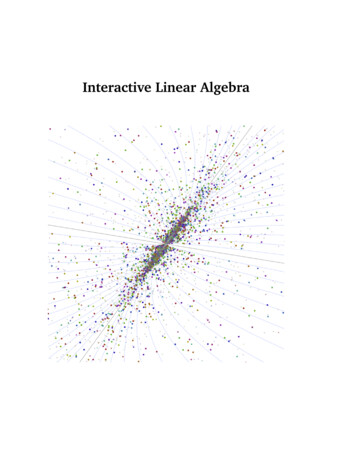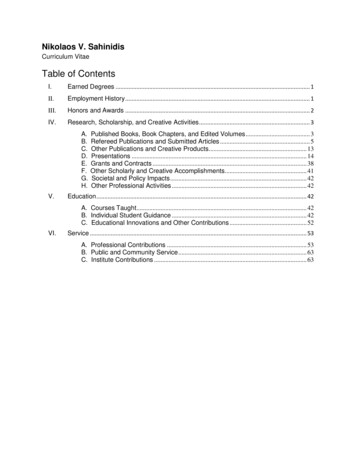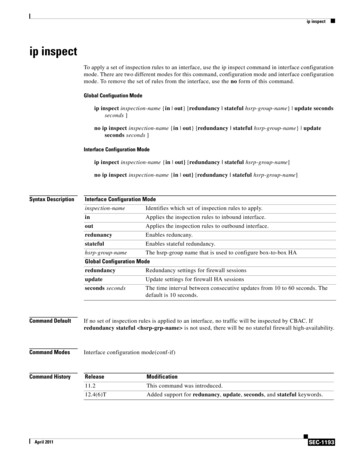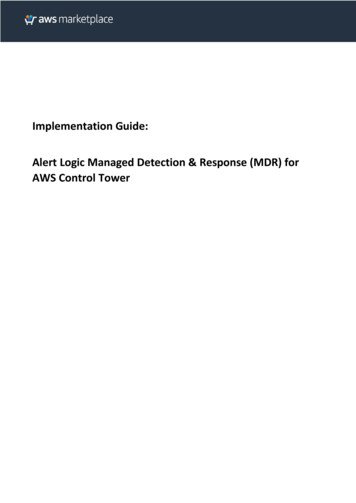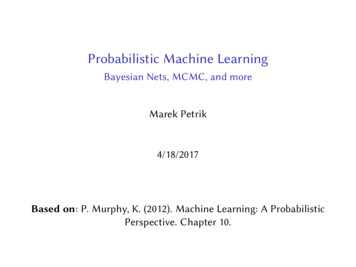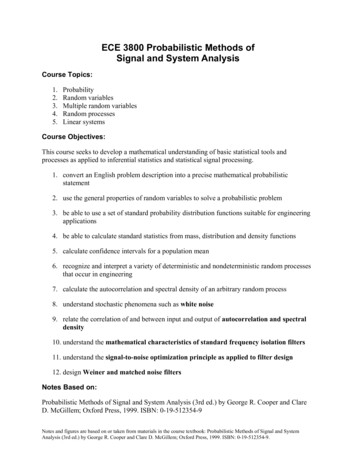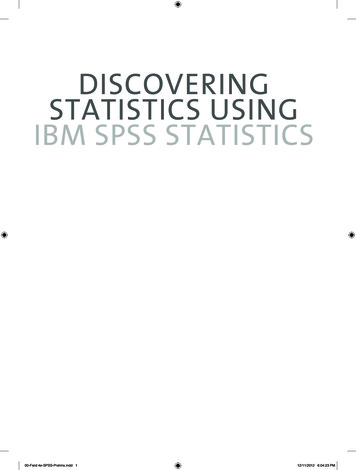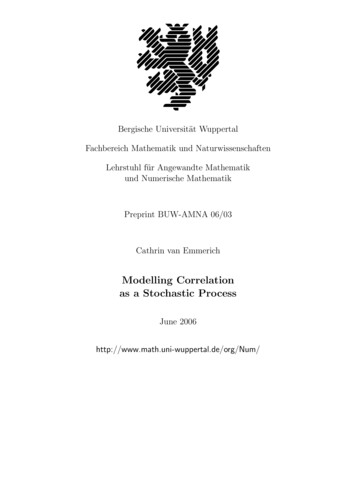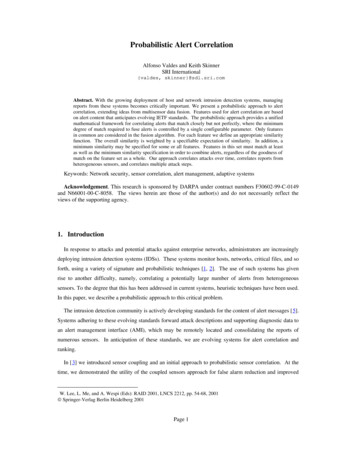
Transcription
Probabilistic Alert CorrelationAlfonso Valdes and Keith SkinnerSRI International{valdes, skinner}@sdl.sri.comAbstract. With the growing deployment of host and network intrusion detection systems, managingreports from these systems becomes critically important. We present a probabilistic approach to alertcorrelation, extending ideas from multisensor data fusion. Features used for alert correlation are basedon alert content that anticipates evolving IETF standards. The probabilistic approach provides a unifiedmathematical framework for correlating alerts that match closely but not perfectly, where the minimumdegree of match required to fuse alerts is controlled by a single configurable parameter. Only featuresin common are considered in the fusion algorithm. For each feature we define an appropriate similarityfunction. The overall similarity is weighted by a specifiable expectation of similarity. In addition, aminimum similarity may be specified for some or all features. Features in this set must match at leastas well as the minimum similarity specification in order to combine alerts, regardless of the goodness ofmatch on the feature set as a whole. Our approach correlates attacks over time, correlates reports fromheterogeneous sensors, and correlates multiple attack steps.Keywords: Network security, sensor correlation, alert management, adaptive systemsAcknowledgement. This research is sponsored by DARPA under contract numbers F30602-99-C-0149and N66001-00-C-8058. The views herein are those of the author(s) and do not necessarily reflect theviews of the supporting agency.1. IntroductionIn response to attacks and potential attacks against enterprise networks, administrators are increasinglydeploying intrusion detection systems (IDSs). These systems monitor hosts, networks, critical files, and soforth, using a variety of signature and probabilistic techniques [1, 2]. The use of such systems has givenrise to another difficulty, namely, correlating a potentially large number of alerts from heterogeneoussensors. To the degree that this has been addressed in current systems, heuristic techniques have been used.In this paper, we describe a probabilistic approach to this critical problem.The intrusion detection community is actively developing standards for the content of alert messages [5].Systems adhering to these evolving standards forward attack descriptions and supporting diagnostic data toan alert management interface (AMI), which may be remotely located and consolidating the reports ofnumerous sensors. In anticipation of these standards, we are evolving systems for alert correlation andranking.In [3] we introduced sensor coupling and an initial approach to probabilistic sensor correlation. At thetime, we demonstrated the utility of the coupled sensors approach for false alarm reduction and improvedW. Lee, L. Me, and A. Wespi (Eds): RAID 2001, LNCS 2212, pp. 54-68, 2001 Springer-Verlag Berlin Heidelberg 2001Page 1
detection performance. We also introduced a correlation approach based on feature-specific similarityfunctions. The correlation example cited at that time consisted of a single sensor examining a probe thatwas distributed in time. Since then, we have introduced some important innovations: Capability to comprehend heterogeneous sensors. Introduction of the probabilistic minimum match criterion, which prevents spurious matches on lessimportant features from causing the system to correlate alerts. By specifying minimum match of unity,this capability causes the system to function as a rule-based correlation system. Explicitly toleratingslightly imperfect matches provides an important generalization of rule-based correlation methods. Hierarchy of sensor correlation: thread, incident, and correlated reports from multistep attackscenarios.We have also gained considerable experimental experience in both live and simulated environments.The remainder of this paper is organized as follows. We introduce our approach to alert fusion, usingour defined alert template to report alerts from EMERALD and third-party sensors. We introduce notionsof feature overlap, similarity, expectation of similarity, and minimum similarity. We show how these areused to achieve a hierarchy of alert correlation defined as inferred thread (within sensor), security incident(between sensor) and correlated attack report (between sensor and attack step). We then present preliminaryresults from the alerts generated by various EMERALD and third-party monitors [1, 2].2. Sensor Correlation and Alert FusionIn [3], we introduced probabilistic methods for sensor correlation. Specifically, we considered twoclosely coupled sensors, a TCP misuse monitor and an asset availability monitor. Both are based on Bayesinference [4], and the former sensor is aware of the state of the latter. Sensor coupling in this fashion iseasily expressed in Bayes formalisms; specifically, the coupling is achieved by dynamically modifyingpriors in the TCP session monitor. The approach demonstrated two important capabilities: Failed accesses to services that appear to be invalid are viewed with greater suspicion than other failedaccesses. This greatly increases sensitivity against certain stealth probe attacks. Certain types of failed access to services that appear “down” are tolerated, so that when a service fails(for malicious or accidental reasons) we do not generate a large number of false alarms.Having demonstrated the utility of sensor fusion for improved sensitivity and false alarm reduction, wehave further explored the general problem of sensor correlation. In particular, we examine the situation ofmultiple heterogeneous sensors on diverse platforms, considering realistic problems of late reports andclock drift.
Our correlation algorithm considers features as reported in a standard alert template. For each matchablefeature, we have defined an appropriate similarity function that returns a value between 0 and 1. Newalerts are compared to a list of existing meta alerts. The overall similarity is the weighted average of thefeature similarities, with expectation of similarity as the normalizing weights. If the minimum matchcriterion fails for any feature, the match is rejected regardless of the overall similarity. The new alert iscorrelated with the most similar meta alert, assuming the similarity is above a specified minimum matchthreshold. Otherwise, the new alert starts a new meta alert thread.2.1Meta Alerts and the Alert TemplateWe have defined an enhanced alert template that enriches standards such as IETF/IDWG [5] withrespect to content while avoiding issues of language specifics. Our template includes the concept of alertthread, which is present in all EMERALD monitors and alert management components. Alert reports arepart of the same thread if they are from the same sensor and refer to the same attack, possibly separated intime. Where provided, such as is the case with EMERALD monitors, the thread mechanism causes newreports for an existing thread to be treated as updates, dramatically reducing clutter on a display interfacethat comprehends threads. For this reason, we identified the capability to reliably infer thread when thesensor does not provide one as a very desirable capability of alert correlation.We include an “anomaly” field in addition to the “confidence” field used in the evolving IETF standard.We also include arrays to describe in greater detail the target(s) of an attack (for example, the specific portsscanned). Finally, we include fields describing the sensor type and placement, enabling us to identify eachunique instantiation of any sensor in the monitored domain.This template is presently used by a diversity of sensors employing both signature and probabilistictechniques. This includes sensors that we have developed under the EMERALD program, as well asprototype wrappers for ISS RealSecure and Checkpoint Firewall-1. Our early experiments indicate thatdiverse sensors will be able to fill this template with content that will be more useful to correlation enginesthan is currently available.2.2Feature SimilarityOur probabilistic alert fusion approach considers feature overlap, feature similarity, minimum similarity,and expectation of similarity. We maintain a list of “meta alerts” that are possibly composed of severalalerts, potentially from heterogeneous sensors. For two alerts (typically a new alert and a meta alert), webegin by identifying features they have in common (feature overlap). Such features include the source ofthe attack, the target (hosts and ports), the class of the attack, and time information. With each feature, wePage 3
have a similarity function that returns a number between 0 and 1, with 1 corresponding to a perfect match.Similarity is a feature-specific function that considers such issues as How well do two lists overlap (for example, list of targeted ports)? Is one observed value contained in the other (for example, is the target port of a denial-of-service(DOS) attack one of the ports that was the target of a recent probe)? If two source addresses are different, are they likely to be from the same subnet?For attack class similarity, we maintain a matrix of similarity between attack classes, with values ofunity along the diagonal and off-diagonal values that heuristically express similarity between thecorresponding attack classes. We prefer to consider attack classes rather than attack signatures, which aremuch more specific and numerous but may be erroneously or incompletely reported. For example, in ourdemonstration environment, we run a variant of mscan that probes certain sensitive ports, that is, it is of theattack class “portsweep”. Our host sensors have a specific signature for this attack and call it “mscan”.The Bayes sensor trades specificity for generalization capability and has no “mscan” model, butsuccessfully detects this attack as a “portsweep”. These reports are considered similar (S 1) with respectto attack class.Not all sensors produce all possible identifying features. For example, a host sensor provides processID, while a network sensor does not. Features not common to both alerts are not considered for the overallsimilarity match.The meta alert itself supports the threading concept, so we can visualize composing meta alerts frommeta alerts.2.3Situation-Specific Similarity ExpectationAn important innovation we introduce is expectation of similarity. As with similarity, this is alsobetween 0 and 1, and expresses our prior expectations that the feature should match if the two alerts arerelated, considering the specifics of each. For example, two probes from the same target might scan thesame set of ports on different parts of our subnet (so expectation of matching target IP address is low).Also, some attacks such as SYN FLOOD spoof the source address, so we would allow a match with anearlier probe of the same target even if the source does not match (expectation of match for source IP islow).We now give some examples of how expectation of similarity depends on the situation, that is, thefeatures in the meta alert and the new alert.If an alert from a sensor has a thread identifier that matches the list of sensor/thread identifiers for somemeta alert, the alert is considered a match and fusion is done immediately. In other words, the individual
sensor’s determination that an alert is an update of or otherwise related to one of its own alerts overridesother considerations of alert similarity.If the meta alert has received reports from host sensors on different hosts, we do not expect the targethost feature to match. If at least one report from a network sensor has contributed to the meta alert and ahost sensor alert is received, the expectation of similarity is that the target address of the latter is containedin the target list of the former.In determining whether an exploit can be plausibly considered the next stage of an attack for which aprobe was observed, we expect the target of the exploit (the features host and port) to be contained in thetarget host and port list of the meta alert.Some sensors, particularly those that maintain a degree of state, report start and end times for an attack,while others can only timestamp a given alert. The former deal with time intervals, while the latter do not.Similarity in time comprehends overlap of the time intervals in the alerts considered for correlation, as wellas the notion of precedence. We do not penalize time similarity too far from unity if the time difference isplausibly due to clock drift.Deciding whether the attacker is similar is somewhat more involved. In the case of an exact match oforiginating IP address, similarity is perfect. We assign high similarity if the subnet appears to match. Inthis way, a meta alert may potentially contain a list of attacker addresses. At this point, we considersimilarity based on containment. In addition, if an attacker compromises a host within our network (asinferred by a successful outcome for an attack of the root compromise class), that host is added to the list ofattacker hosts for the meta alert in question. Finally, for attack classes where the attacker’s address is likelyto be spoofed (for example, the Neptune attack), similarity expectation with respect to attacker address isassigned a low value.2.4Minimum SimilarityOur correlation component implements not just expectation of similarity (which effectively acts as aweight vector on the features used for similarity matching) but also enforces situation-specific minimumsimilarity. Certain features can be required to match exactly (minimum similarity for these is unity) orapproximately (minimum similarity is less than unity, but strictly positive) for an alert to be considered as acandidate for fusion with another. Minimum expectation thus expresses necessary but not sufficientconditions for correlation.The overall similarity between two alerts is zero if any overlapping feature matches at a value less thanthe minimum similarity for the feature (features for which no minimum similarity is specified are treated ashaving a minimum similarity of 0). Otherwise, overall similarity is the weighted average of the similaritiesof the overlapping features, using the respective expectations of similarity as weights.Page 5
By appropriate settings of similarity expectation and minimum similarity, the correlation componentachieves the following hierarchy of correlation. The system is composable in that we can deploy multipleinstances to obtain correlation at different stages in the hierarchy. For example, we can infer threads(within sensor correlation) and then correlate threaded alerts from heterogeneous sensors into securityincidents.Synthetic Threads: For sensors that do not employ the thread concept, the correlation synthesizesthreads by enforcing high minimum expectation similarity on the sensor itself (the thread must come from asingle sensor) and the attack class, as well as source and target (IP and ports). We have wrapped the alertmessages from a leading commercial sensor and observed that this facility reliably reconstructs threads.In particular, by placing an aggregator component topologically close to an IDS, the pair is made robustagainst attacks that cause the IDS itself to flood, as described in a recent NIPC advisory [6].Security Incidents: By suppressing minimum expectation of similarity on the sensor identifier, andrelaxing expectation of similarity for this feature, we can fuse reports of the same incident from severalheterogeneous sensors into a single incident report. In this case, we enforce a moderately high expectationof similarity on the attack class. This is not unity because different sensors may report a different attackclass for the same attack. We construct a table of distances between attack classes that expresses whichones are acceptably close. For security incident correlation, we enforce minimum expectations on thesource and target of the attack. Using this technique, we have been able to fuse alert reports fromcommercial and EMERALD sensors into security incident reports.Correlated Attack Reports: By relaxing the minimum expectation of similarity on the attack class, weare able to reconstruct various steps in a multistage attack. Each stage in an attack may itself be acorrelated security incident as described above. In this fashion, it is possible to recognize a staged attackcomposed of, for example, a probe followed by an exploit to gain access to an internal machine, and thenusing that machine to launch an attack against a more critical asset.2.5Feature FusionWhen the system decides to fuse two alerts, based on aggregate similarity across common features, thefused feature set is a superset of the features of the two alerts. Feature values in fused alerts are typicallylists, so alert fusion involves list merging. For example, suppose a probe of certain ports on some range ofthe protected network matches in terms of the port list with an existing probe that originated from the sameattacker subnet, but the target hosts in the prior alert were to a different range of our network. The attackeraddress list has the new attacker address appended, and the lists of target hosts are merged. The port listmatches and is thus unchanged.
Two important features are the sensor and thread identifiers of all the component alerts, so that theoperator is always able to examine in detail the alerts that contribute to the meta alert report.One additional feature is the priority of the meta alert, supported by our template and provided byEMERALD sensors. We are developing a component that estimates criticality based on the assets affected,the type of attack, the likelihood of attack success, and an administrative preference. The aggregatormaintains the high water mark for this field. We are investigating approaches whereby the contributingthreads are permitted to update their priority downward, computing meta alert priority as the maximumacross thread priorities at any given time. This approach would permit downward revision of the meta alertpriority.The features presently considered in the probabilistic correlator component include sensor identification(identifier, location, name), alert thread, incident class, source and target IP lists, target TCP/UDP port lists,source user id, target user id, and time. Computations are only over features that overlap in the alert to bemerged and the candidate meta alert into which it is to be merged. Incident signature is used as well, butwith a low expectation of similarity as these vary widely across heterogeneous sensors.If present, a thread identifier from the reporting sensor overrides other match criteria. A new alert thatmatches the sensor and thread of an existing meta alert is considered an update of the earlier alert.The correlator first tries to infer a thread by looking for an exact match in sensor identification andincident class and signature. Note that alerts that are inferred to be from the same thread may be separatedin time. The system attempts to infer threads even in incident and scenario operational modes.Next the system checks that all overlapping features match at least at their minimum similarity value.Setting minimum expectation for some features to unity (not normally recommended) causes the system tobehave like a heuristic system that requires exact matches on these features. Given that this criterionpasses, we compute the overall similarity between the two alerts as follows:SIM ( X,Y) E j SIM ( Xj ,Yj )j E jjX Candidate meta alert for matchingY New alertj Index over the alert featuresE j Expectation of similarity for feature jX j,Y j Values for feature j in alerts X and Y, respectively (may be list valued)Incident class similarity is based on a notion of proximity, which at present is the result of ourjudgement. The proximity of class A to B reflects how reasonably an attack currently of incident class Amay progress to class B. Note that this is not symmetric; we more strongly expect an exploit to follow aPage 7
probe than the other way around. The incident classes are from the EMERALD 602 message format. Notethat some “default” classes such as “invalid” and “action logged” are reasonably proximal to most otherclasses.This is because the IETF standard does not require a common ontology, and reports fromheterogeneous sensors for the same incident may not reliably represent this field. As such, we do not wantto reject potential matches based on this field alone.For operational modes other than thread level aggregation, we do not recommend a high minimumsimilarity value for this field.INVALIDINVALIDPRIVILEGE VIOLATIONUSER SUBVERSIONDENIAL OF SERVICEPROBEACCESS VIOLATIONINTEGRITY VIOLATIONSYSTEM ENV CORRUPTIONUSER ENV CORRUPTIONASSET DISTRESSSUSPICIOUS USAGECONNECTION VIOLATIONBINARY SUBVERSIONACTION .60.60.60.61Table 1. Incident Class Similarity MatrixFor two alerts that are extremely close in time, it is possible that the alerts may not be in time order. Inthis case, incident class similarity is the greater of SIM(X, Y) and SIM (Y, X). Mathematically, thesimilarity computation for incident class can comprehend a discrete call (the alert is from one of the aboveclasses) or a call that is a probability distribution over the above classes (as might result from a meta alertin which the contributing sensors do not agree on the class).
Most other features are potentially list-valued. For lists, the notion of similarity generally expresses thefraction of the smaller list that is contained in the larger. For source IP addresses, similarity also attemptsto express the notion that the addresses in question may come from the same subnet.Time similarity is a step function that drops to 0.5 after one hour. A close match in time is expectedonly when the system operates in “incident” mode. Thread and scenario aggregation may be over timeintervals of days.3. Results3.1Live DataThe following is an example of alert correlation over time, in this case correlating alerts that arecomponents of a stealthy port sweep. The following is an example of one of the contributing alerts. In theinterest of space, we do not include all the content that is in the alert and meta alert templates, but limitourselves to the fields needed to illustrate the result.Thread ID 69156 Class portsweepBEL (class) 0.994 BEL(attack) 1.0002001-06-15 17:34:35 from xx.yyy.148.33 ports 1064 to 1066 duration 0.000dest IP aaa.bbb.30.1173 dest ports: 12345{2} 27374{3} 139This is a probe for 3 vulnerable ports on a single IP address in the protected network, and is detected bythe system described in [2]. The above is just a single step in a probe that apparently transpired overseveral days, and resulted in the following correlated meta alert.Meta Alert Thread 248Source IPs source IParray: xx.yyy.148.33 xx.yyy.148.47Target IPs target IParray: aaa.bbb.30.117 aaa.bbb.6.232 aaa.bbb.8.31aaa.bbb.1.166 aaa.bbb.7.118 aaa.bbb.28.83 aaa.bbb.19.121aaa.bbb.21.130 aaa.bbb.6.194 aaa.bbb.1.114 aaa.bbb.16.150From 2001-06-15 17:34:35 tocorrelated alert priority -12001-06-21 09:19:57Ports target TCP portarray: 12345{4} 27374{4} 139{3}Number of threads 10 Threads :69156 71090 76696 84793 86412 87214Page 9
119525 124933 125331 126201Fused: PORT SCANWe note that we have correlated events from two source addresses that were judged to be sufficientlysimilar. The attack is quite stealthy, consisting of a small number of attempted connections to single targethosts over a period of days. The list of thread identifiers permits the administrator to examine any of thestages in the attack. In this case, each attack stage is considered a portsweep; if the stages consisted ofdifferent attack classes, these would be listed under “Attack steps”. Over the three week time periodcontaining this attack, the IDS sensor processed over 200,000 sessions and generated 4439 alerts. Theprobabilistic correlation system produced 604 meta alerts.3.2Experimentation EnvironmentThe experimentation environment simulates an electronic commerce site, and provides Web and mailservices over the Internet. The protected network is behind a firewall, and is instrumented with severalhost, network, and protocol monitors. Two machines are visible through the firewall, and two auxiliarymachines are used for network monitors and alert management. The firewall blocks all services other thanWeb, FTP, and mail. We have simulated traffic that appears to come from a number of sources, and anattacker who executes certain well-known attacks. The background traffic includes legitimate anonymousand nonanonymous FTP use; the latter triggers false alarms in some signature sensors. There are also lowpriority nuisance attacks, as well as low-level failed accesses to blocked ports, which trigger firewall logmessages.The attack begins with an MSCAN probe to the two machines visible through the firewall. EMERALDeBayes and eXpert-Net sensors the two machines detect this and set the attack code for mscan in their alertreport. The Bayes network sensor detects the attack as of the class “portsweep”. The target port lists forthese alerts match, as does the attacker address. Similarity with respect to the target address depends on theorder in which the alerts arrive (the order at which the alerts arrive is not deterministic as the sensors aredistributed). Until the network sensor’s alert is received, we do not expect target addresses to match fordistinct sensors, since a host sensor can typically report only its own address as a target. We expect thenetwork sensor’s target list to contain the targets seen by host sensors (tolerating imperfect matches due toarrival order), and we expect the target address of subsequent host alerts to be contained in the meta alert’starget host list. Therefore, regardless of arrival order, these alerts are acceptably similar with respect totarget host.The attacker next uses a CGI exploit to obtain the password file from the Web server. This exploit isdetected by the host sensor. The next stage of the attack is a buffer overflow to gain access on the hostproviding mail service, detected by an EMERALD host sensor as well as by ISS.
Although telnet through the firewall is blocked, the attacker may telnet (using a password obtained fromthe earlier exploit) from the compromised internal host to the critical host, and he now does so. On thathost, he uses another overflow attack to obtain root access. He is now free to change Web content.Figure 1 shows the EMERALD alert console for this scenario, containing alert reports for the aboveattack steps as well as alerts due to false alarms and nuisance attacks. It is not very informative, except toshow that more than 1000 alerts are received for this scenario, which lasts approximately 15 minutes, andthe critical attack is effectively buried.Fig. 1. Raw Sensor Alerts for the Simulated Attack ScenarioThe majority of the alerts are from nonanonymous FTP write operations, which are allowed but triggeralerts from a commercial sensor.Figure 2 shows the result of inferring synthetic threads for sensors that do not support the threadingconcept. For alert thread inference, we set the minimum match for sensor identifier fields to unity, andrequire a high match for attacker and target parameters as well; we do not require a minimum similarity inthe time field to allow inference of threads that occur slowly over time. Most of the alerts are threaded intosessions according to originating IP address, and the total number of alerts reported is reduced to aboutPage 11
sixty. We have highlighted an alert, which is one of the nuisance TCP sweep attacks in the backgroundtraffic.Fig. 2. Alert Fusion via Synthetic Thread InferenceFor attack incident matching, we must look across sensors to determine if several alerts refer to the samesecurity incident. We suppress minimum similarity for sensors, set a moderately high similarity forattacker and target identifiers, and set a moderate minimum for time (to allow for clock drift and sensorresponse time differences). We also require a match in attack class, making allowances for sensors thatreport different attack classes for a given attack sequence. Figure 3 shows the result of incident matchingfor the attack scenario. Some of the critical steps in the attack reported by several sensors now result in asingle alert. For example, the highlighted buffer overflow attack is reported by an EMERALD sensor aswell as by ISS. These are fused into a single correlated incident report. The two mscan reports fromEMERALD host sensors and the portscan report from the EMERALD Bayes TCP sensor are also fusedinto a single incident.
Fig. 3. Security IncidentsThe final step in correlation is an attempt to reconstruct the attack scenario. We now relax attack classsimilarity to consider what attack steps might follow the present step. For example, it is reasonable tofollow a probe with an exploit to a target “contained” in the probe. Also, if the meta alert includes a stepindicating a likely root compromise, the host in question is added to the attacker’s assets (that is, it
Page 1 Probabilistic Alert Correlation Alfonso Valdes and Keith Skinner SRI International {valdes, skinner}@sdl.sri.com Abstract. With the growing deployment of host and network intrusion detection systems, managing
